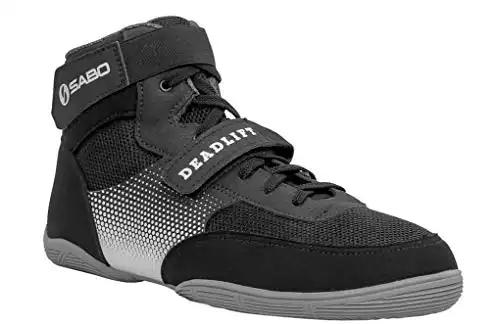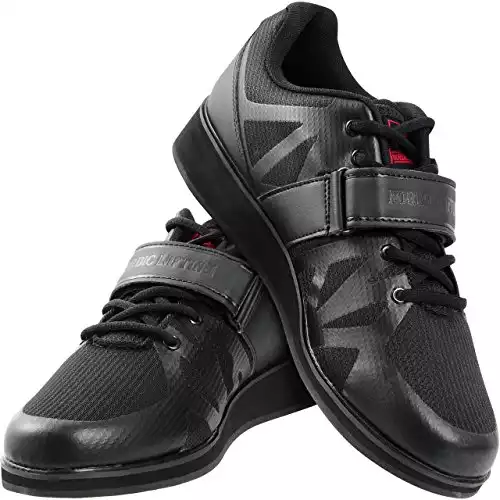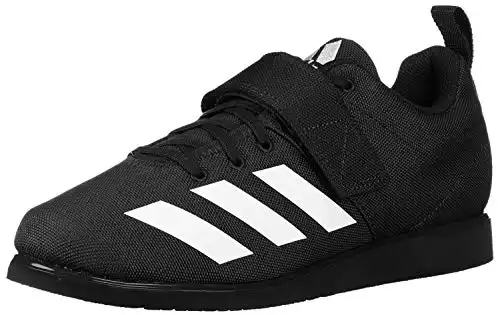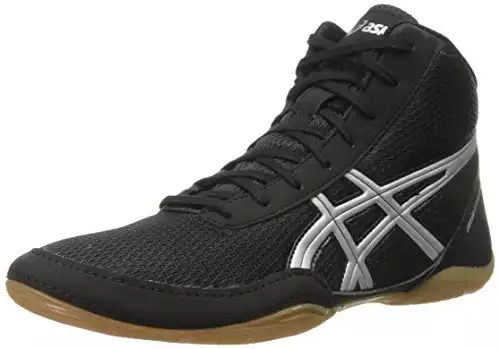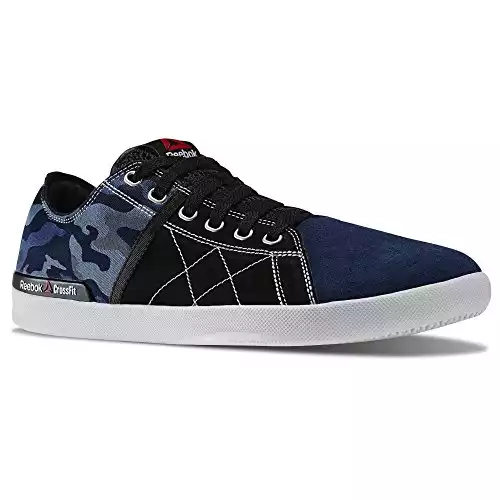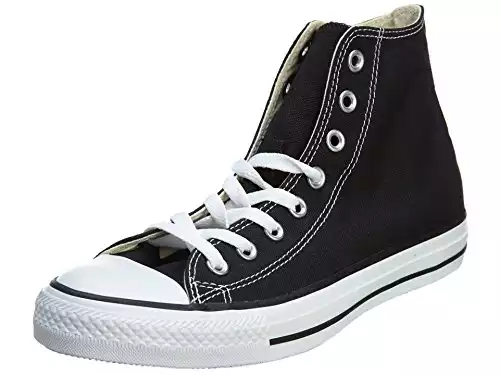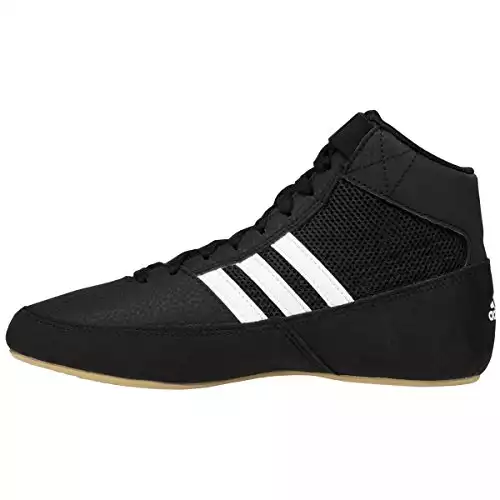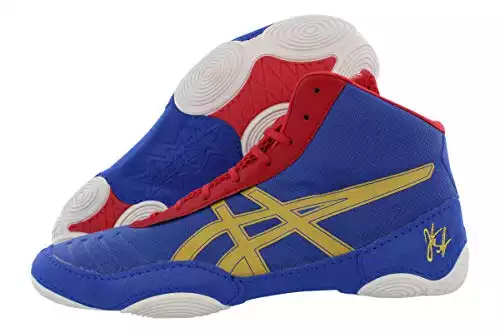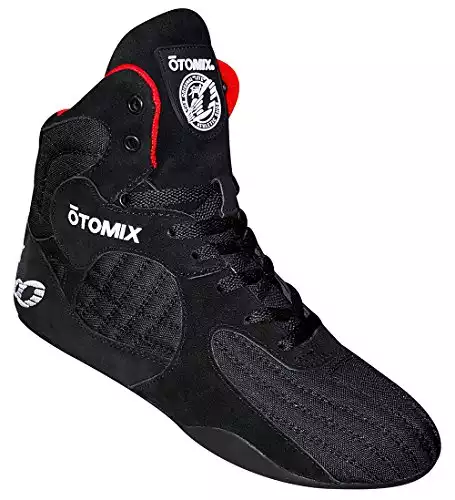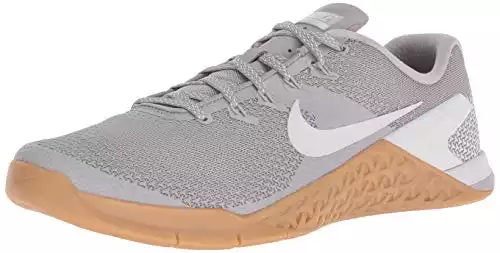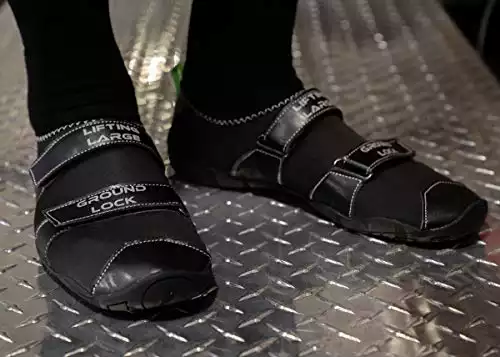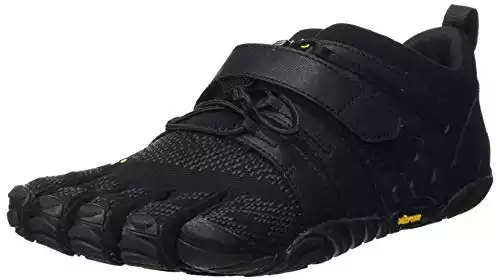Some links in this article are affiliate links, which means I earn from qualifying purchases.
There was a time when I had just set off on my fitness journey and didn't know, nor understand the mighty deadlift.
Today, I absolutely love deadlifts.
Want one move that works the sides of your legs, posterior, back, and the all-important core?
Light a fire in your belly, hamstrings, and glutes now, and get deadlifting!
Eventually you discover that the deadlift has many technical aspects which can affect your ultimate progress.
One of the factors being foot placement and shoes.
Certain shoes are better for deadlifting than others. If you really want to get the most out of your deadlifts, get shoes designed for the lift.
The 12 Best Deadlift Shoes are:
- 1SABO Deadlift Shoes
- 2Nordic Lifting Powerlifting Shoes
- 3Adidas Powerlift 4
- 4Asics Matflex Wrestling Shoe
- 5Reebok TR Lite
- 6Converse Chuck Taylors
- 7Adidas Wrestling HVC Shoe
- 8ASICS JB Elite V2.0 Wrestling Shoe
- 9Otomix Stingray Boxing Shoe
- 10Nike Metcon 4
- 11LiftingLarge Deadlift Slipper
- 12Vibram FiveFingers Minimalist Shoe
Whether you've been training for a while or are just starting, I'd like to take you through just why you need a deadlift shoe and the best you can buy. Ready? Set? Lift!
In a Hurry? Here Is My Recommendation
To cut a very long search short, the SABO Deadlift Shoe is all around the best one on the market.
Great for Sumo, Romanian, or the Straight-Leg deadlift, these shoes are lightweight and sturdy. Very worth the investment.
Plus they have all those constructional qualities that matter to anyone remotely serious about their training or sport. The material, breathability, support and fit are exactly what you need to make a great deadlift happen.
8 Great Benefits Of Deadlift Shoes
Wearing a proper deadlift shoe while you’re powerlifting brings nothing but benefits with it. You don’t have to be lifting at the gym like a pro, but if this is a practice you’re committed to, having the correct gear is going to make all the difference.
By the way, when I say difference, I don’t mean in just one area of your practice.
Firstly, let’s just be real basic and consider why we wear shoes at all.
The idea is to protect your feet from injuries and the elements as you get around. That’s it. Apply this to deadlifting.
The idea is to protect your feet and ankle while you lift weight equal to or greater than your own.
The second purpose of proper deadlift shoes is to help you with your posture. You need a certain amount of foot-to-floor force and as with most posture-related exercise, need your spine neutral and sternum lifted.
The right shoe will help you do that even with heavier weights plated on to your barbell.
1. Keeps Your Feet Close To The Ground
A typical deadlift shoe will have a heel height of ½ to ¾ inches. This slight raise in the heel allows your knees more flex. In turn, this engages muscle mass as you lift, improving the effect.
Other factors come into play, such as genetics and build. However, slipping on a shoe before you get deadlifting is never a bad idea.
2. Keeps You Firmly On Your Feet
Take a second and do a self-scan of all the muscles I mentioned above. You're throwing in your legs and glutes, your back and core, into a deadlift.
Bending down and lifting something off the ground is a basic, everyday move. However, even that basic move can go awry if your feet aren't firmly planted.
Deadlift shoes give you the edge of balance. You're going to be lifting a pretty heavy weight and you'll need the balance!
The flat, tough sole of a good deadlift shoe keeps your feet close to the ground, thereby ensuring your lower body is stable as you lift.
While the shoes' hard soles help support your foot in its entirety while you lift, they also allow direct foot-to-floor contact.
3. Encourages A Stable Foot
To perform a successful deadlift, you need a stable foot.
A stable foot is one with a reduced motion of your naturally very mobile feet. Wearing the right shoes can help you get there.
The raised heel – albeit very slightly – of deadlift shoes can help to keep the feet stable while lifting. The tough sole helps to maintain a neutral arch in the foot.
The lateral gastrocnemius, soleus, and peroneals – your lower leg muscles will also benefit from less tension thanks to the right shoe's support.
4. Helps Prevent Discomfort
In my exploration of the deadlift, I've learned – often the hard way – which parts of my feet will take the worst beating in the wrong shoes.
Let me elaborate.
But first, a very quick anatomy check: the upper bones and lower arch of your feet need all the support they can get as you lift. The metatarsal region – the upper bones – needs to be held in place snugly while allowing unrestricted blood flow.
Most modern deadlift shoes come with a strap designed to support the metatarsal area without constricting it too much.
Simultaneously, the arch of your foot needs acknowledgment too.
Yes, we need to restrict the range of motion of the foot. But we need to do it with a little arch support as a nod to the natural engineering of our feet.
Luckily for us, most deadlift shoes do bring that arch love. With the metatarsal strap, the lifted arch helps your feet remain comfortable while you lift while keeping motion in check.
5. Supports Your Feet
Your ankle and mid-foot play a pivotal role in your deadlift. Deadlift shoes are built to provide maximum support to both these parts during the lift.
While the slight lift in the heel of a deadlift shoe gives you the added advantage of a slight ways further, you will need to pull your weight.
It does so while completely protecting the bottom of the foot. A lot of deadlift shoes also feature a strapped collar. Shoes with strapped collars also aid in supporting your feet as you lift.
The ankle remains protected and stays balanced thanks to this strapped collar.
If you deadlift regularly, you know that your ankle joint needs to have restricted upward mobility as you go.
At the same time, you need a level of flexibility. The strapped collar is usually adjustable, so you can fix it at the point that works best for you, with the right amount of both support and "give."
6. Prevents Injuries
The worst thing to happen to anyone while performing a deadlift is to hurt one of the many little bones and muscles that make up the foot, simply, well, because they put a foot wrong.
That is to say – again! – your foot needs to be stable and balanced while you lift.
Deadlift shoes are built to hold your feet and support them in a way that encourages correct performance.
These shoes are also not prone to slipping. They're made to stay put. Do you know what can happen if your foot slips ever-so-slightly while you lift? You can strain your feet, or worse, drop the plates of your weight on your feet.
Slip on some non-slip deadlift shoes to make that problem go away, posthaste.
8. Let’s You Lift, Replicate, Repeat!
If your foot is supported, the arch is encased naturally, and your metatarsal region is snugly protected, you've got the right recipe for a proper deadlift.
All this support works towards you maintaining the correct posture for a deadlift. Speaking in broad terms, when you've got the posture down, you are in a position to replicate it and improve upon it.
Top 12 Picks For Best Deadlift Shoes
For each product, I’m going to discuss the technical details that directly affect your squatting performance. Then, I’ll mention the pros and cons I found in the customer reviews.
1. SABO Deadlift Shoes
Pros
Cons
You know a shoe is not kidding around about its purpose when it states it on the front strap!
The SABO Deadlift Shoes' front straps bear a stamp reading 'Deadlift,' so you know exactly what you're getting with these shoes.
SABOs are considered the best deadlifting shoes on the market. The soles are a mere 2-5 mm thick, which I found were just thin enough, plus designed specially to lend the traction I needed for my lift.
2. Nordic Lifting Powerlifting Shoes
Pros
Cons
Kind of a surprise discovery here, and I think anyone would like to give these a go based on the reviews alone. As far as the requirements for deadlift shoes go, Nordic Lifting Powerlifting Shoes are fulfilling them all. The specs are one thing. What I like is what these specs claim to achieve.
These are stable shoes that improve your lifting posture. I mean, that is the deadlifter’s dream, right? Plus, they're durable. Now I don't get a lot into the price of a product usually, but here's a tip, kids: price matters, and therefore durability matters.
3. Adidas Powerlift 4
The Adidas Powerlift 4
The Adidas Powerlift 4 features an updated, narrower fit with a die-cut midsole wedge, rubber outsole, and wide instep strap for maximum stability.
Pros
Cons
One of the shoes that come roundly well-recommended for deadlifting is the Adidas Powerlift 4. There are a lot of structural benefits to this shoe. Its canvas upper construction makes the shoe durable while helping you achieve just the right amount of flexibility.
The sole is synthetic and solid. The sturdiness and toughness of the sole lend extra support as you lift.
Personally I found that even as I added weight to my lift, the soles helped keep me more grounded and gave me more floor-to-foot force transfer.
4. Asics Matflex Wrestling Shoe
Pros
Cons
These are wrestling shoes, but us deadlifters swear by them. Why? Wrestling shoes are generally constructed along the lines of good weightlifting shoes.
100% synthetic Lace Garage Technology – which tucks laces away from sight and getting in your way – these shoes are completely flat. I’ve found them to help me keep my balance and my barbell in place while I lift.
They're flat where it matters, as they have no heel elevation. This protects you from losing your balance and keep the barbell on you all the time. Plus, the soles offer a brilliant grip, which is always great.
The only downside to these shoes, which I'll label more of an annoyance, is that sizes run toward smaller/narrower. Ultimately though, I'm glad I bought them and had the chance to train in them.
5. Reebok TR Lite
Pros
Cons
The Reebok TR Lite is a nice-looking shoe if that matters to you, and I've had my partners in deadlifting comment offhandedly about the nice men and women’s variety they offer. Fans of the shoe also report that the shoe fits perfectly, which we’ve learned matters a lot for balance and range of movement.
It’s a fairly durable shoe with a low-cut silhouette. A full rubber outsole provides amazing grip. There's a suction-cup-like design on the sole which grasps onto all kinds of surfaces. The heel-to-toe drop is decent at 4mm, and a heel clip aids in good response and when lifting heavier weights.
6. Converse Chuck Taylors
Pros
Cons
Converse Chuck Taylors are like the old kid on the block. Any deadlifter from the olden times will tell you that this was their footwear of choice when they started mostly because they're so affordable and versatile.
Flat, sturdy soles make these a winner for deadlifting. They let us achieve the coveted stable foot in the way they divide weights, resulting in a stable deadlift.
The canvas construction is made for stability, and the ankle collar is pretty good at stabilizing the ankle. Rubber soles offer minimal compression. However, they are not as dead-on a choice for deadlifts, because ultimately, they have a 10 mm sole and were not built for weight/deadlifting.
7. Adidas Wrestling HVC Shoe
Pros
Cons
The Adidas name is synonymous with sport and sport science, and the Men’s Wrestling HVC Shoe is one of the top-selling shoes on Amazon with tons of reviews and a great rating.
Constructed with synthetic leather and suede, with a rubber sole, this is a shoe you can rely on to function well. Apart from its qualities for working as a deadlifting shoe, it is also layered in mesh, which lets your feet breathe while you work out.
8. Asics JB Elite V2.0 Wrestling Shoe
Pros
Cons
The Asics JB Elite V2.0 wrestling shoe is a good investment even though it is designed for wrestling, not deadlifting. Don't let the specs that talk about wrestling-intended features trick you into thinking you couldn't deadlift in these.
The traction pods, designed to work for wrestling, actually work great for providing the grip you need when deadlifting.
Made with 100% synthetic materials, Asics JB Elit V2.0 is built on the specific directions of two-time World and Olympic Champion Jordan Burroughs.
They look good, work well, and make a strong case for wrestling shoes in the lifting arena.
9. Otomix Stingray Boxing Shoe
Pros
Cons
From wrestling to boxing, we’ve got a bunch of types of shoes moonlighting as deadlifting shoes.
These Otomix Stingray Boxing Shoes are pretty cool. They help you get in the ring of excellence and are super lightweight.
You'll float like a butterfly and ‘stingray’ like a bee. Are those enough boxing jokes for you?
I love the ankle support on these, with the extended ankle collar. Why do I love this?
The additional ankle support works out for anyone who likes the extra support, and for those who like adding weights to their barbell.
The weight of these shoes is also good for people who like to feel a little freer on the feet. Plus, just because they're lightweight doesn't mean they're not durable.
10. Nike Metcon 4 Training Shoes
Pros
Cons
Durable and secure, that's something we could all just close our eyes and say about any Nike shoe, right? Stability and grip are a pretty big deal to me while lifting, and I like that the Metcon 4 brings that in spades.
For the Metcon 4, the haptic print adds to the durability, and can I just say, I love anything mesh and breathable? It just makes me feel better that while I'm sweating and grunting, at least my feet are getting air! And maybe that’s just in my head, but how you feel while you work out is important too.
If your feet are comfortable, your posture is aligned, and you’re not worried your shoe is going to rip to smithereens if you push too hard against the sides.
11. LiftingLarge Deadlift Slippers
Pros
Cons
Deadlift slippers have only been around for the last few decades, but they've gained tremendous popularity.
The number one choice among powerlifters has been the LiftingLarge Deadlift Slipper.
Built with a thin rubber sole, the slipper prevents slipping and has maximal grip ability.
The two straps on the top of the slipper allow easy adjustability and provides you great tightness.
In addition, there is a 4mm insole which is supposed to provide added comfort but some lifters remove it to get closer to the ground. They come with a 1 year warranty if you're not completely sold on them in that span.
12. Vibram FiveFingers Minimalist Shoe
Pros
Cons
Minimalist Shoes are controversial among lifters.
Even Dr. Aaron Horschig, from SquatUniversity recommends wearing these shoes for lifters who prefer squatting barefoot.
When it comes to deadlifts though, its hard to get closer to the ground than these Vibram FiveFingers Minimalist Shoes.
The zero heel drop combined with the 3.5mm sole allows you to get reduce the distance for your deadlifts. The only thing you may not like about these shoes are how they look!
Deadlift Shoes vs. Barefoot
Deadlifting barefoot, or indeed, performing a range of exercises barefoot, is all the rage right now. Who doesn't love the thought and practice of doing things the way nature intended?
I mean, I see it. I've been there. I can tell you why the barefoot trend is so, well, on-trend.
Firstly, lifting barefoot means you’re already closer to the ground. That automatically reduces motion as you lift.
It also means your sensory instinct is a lot better as your nerves send signals to your brain. So whether you're slightly off-balance, tilting too much in any direction, or need a little more grip – your brain is receiving the message faster.
Read my in-depth guide about Deadlifting Barefoot.
As someone who runs, lunges, lifts, and trains regularly, I feel that the correct footwear adds to your practice. Yes, maybe you’re not getting the benefits of connecting sole directly to the ground, but you are protecting your feet from injuries and retaining the posture you need.
Healthy, well-protected feet mean you are always ready to train, which means you're already adding to your practice.
What To Look For In Deadlifting Shoes
When purchasing your deadlift shoe, just keep a checklist of important things handy. If the shoe ticks these off in descending order, you're good to go.
Sole
Start with the Sole.
You've read what I've spoken about so far; you know sole is important.
Too much sole, and you're not getting as close to the ground as you should be. Too little sole – well, this is one place where that's a good thing.
You don't want cushioning when deadlifting. You want a grip on the floor, and you want to be close to it while being super stable.
Metatarsal Support
Next: think of your Metatarsal Area. For this, you need a shoe with metatarsal support in the shape of straps.
These straps will provide that midfoot support, which again leads us back to the gold standard of lifting: stability.
Besides, I do like the tight connection it brings between the floor and my feet while I lift.
Ankle Support
Ankle Support is a big one.
You want that to reduce ROM and keep the ankle steady. It’s also good for protecting against ankle injuries.
Weight
So while you’re lifting heavy weights, you want your shoe to be light. Weight is an important factor to consider when investing in your deadlift shoe.
Heel Height
Heel Height is something that less is more of when deadlifting.
You might notice that I talk about the heel-to-toe drop a lot when talking about shoes for deadlifting, and there's a reason.
Okay, it's the same reason you want a flat sole: you want to be closer to the ground. That is going to help you bring your deadlift A-game.
Rubber Sole
I love a hard rubber outsole. Firstly, it’s going to give you lots of traction.
Secondly, it’s going to make sure your shoe lasts a little longer. A tightly-packed sole also translates to no compression while lifting. This is where durability comes in.
Construction Quality
What you definitely want to do is check price against quality. Why? Because quality construction, materials, designs, etc., mean the price is perhaps worth it, and you should pay those extra dollars for a product that will serve you better and last you longer.
The quality of the things I just listed also means you’re getting the benefits of a well-constructed deadlift shoe, which in turn helps your deadlift elements get better.
Common Mistakes in Deadlift Shoes
Look, if you’re deadlifting, chances are, you know you need a shoe for the purpose.
However, a lot of us tend to want to overlook certain requirements and maybe make the same piece of equipment multi-function for us like nobody's business.
In a nutshell, no, you cannot wear your regular trainers, running shoes, or sneakers for this. You need all the stuff I mention so much to check out with the shoe you’re deadlifting in.
You need the flat, dense sole. The shoe needs the durable upper. You also need midfoot support. Some of you maybe need the shoe to look good too.
Let me tell you what mistakes you might be making with your deadlift shoes.
An Elevated Heel
We love our soft and cushioned trainers. They break the impact of a hard run or jumping squat and cushion our feet while we are out and about.
They work for the gym and park and for life, and they are great!
So yes, by all means, wear these shoes while you hit the pavement or the gym for an intense workout. But deadlifts? No.
The cushioned and padded soles and inners make for bad deadlift shoes. You need to be closer to the ground, not farther from it.
You want to power through your feet, not have your shoes absorb the effort you're putting into your lift. This means stow away your regular trainers on deadlift day.
They can always come out for other play. But let the big deadlift boys be your shoe when that's what you're doing.
Otherwise, you're at risk for injury and, to be honest, a very non-great workout.
You Don’t Need The Arch
All the shoes I've talked about above have one thing in common: they help you stay flat on your feet. You need that to ensure the weight you're lifting stays on you.
What is the problem with your normal workout shoes, you ask?
The heels on your normal shoes are designed to help you move more. And when deadlifting, your foot needs to be less mobile.
There should be less movement. Everything needs to be flat on the ground and packed into place. Otherwise, you're just kind of leaning into places and angles you shouldn't be.
Add to this the lack of ankle support, the additional arch support in regular running shoes and the like, and you've got a recipe for unsupported ankles that might go every which way or even get hurt.
Bottom line: Regular gym shoes will not give your body the support it needs for deadlifts, resulting in myriad injuries.
You Need To Restrict Motion
Most exercise shoes actually recognize your need to have mobile feet with a free range of motion. Deadlifts are the opposite.
They need your feet to have none to a limited range of motion for the best kind of stability. And you need the best kind of stability to conduct a deadlift that will be successful, not injure you in any way, and give you the kind of weightage on your feet that you need.
Frequently Asked Questions
What Is The Mark Of A Good Deadlift Shoe?
The best kind of deadlifting shoes are flat-soled. If you read up a bit, you will find that some of the shoes best for deadlifting weren't made for the purpose, nor are they marketed as such.
You'll spot a bunch of kinds of shoes working as deadlifting shoes mentioned by professionals and worn by competitive deadlifters.
What these shoes usually have in common is a flat sole, no heel elevation, good metatarsal, and ankle support. Really, if you find these three things in a shoe, you're golden.
What Kind Of Shoes Are The Best Deadlift Shoes?
Anything with the qualities as mentioned above, but we see a lot of Chuck Taylors and Adidas Wrestling Shoes (and other wrestling shoes) stepping for deadlifters.
Some people do like to go it barefoot, while others will step into solid slippers or barefoot-style running shoes.
How Can I Find My Perfect Deadlift Shoe?
Trial and error, baby. I only learned I like the simplest, no-frills but full-specs shoe for my deadlifting because I’ve gone through a lot of them. Start out with one that appeals to you as described, and then build on from there.
Final Thoughts
If I could impart any one final thought to you, it would be this: you might not need the deadlift shoes and probably love working out barefoot anyway, but the pros are higher than the cons. You’re giving yourself an edge here, with an increased rate of force development (check out this shod vs. unshod deadlifting research here).
And to reinforce all that I’ve said, I’ve made some quick bullets for your perusal. As in life, so in deadlifting: wearing shoes is just never something you’ll ever regret, you know?
There are so many who will opt for barefoot styles too or go barefoot.
Whether you're looking for better support or a way to increase your progress, get yourself a pair of deadlift shoes.
References
Hammer M.E., Meir R.A., Whitting J.W., Crowley-McHattan Z.J. Shod vs. Barefoot Effects on Force and Power Development during a Conventional Deadlift. J. Strength Cond. Res. 2018;32:1525–1530. doi: 10.1519/JSC.0000000000002246.
Valenzuela K.A., Walters K.A., Avila E.L., Camacho E.L., Alvarado F. Footwear Affects Conventional and Sumo Deadlift Performance. Sports (Basel). 2021 Feb; 9(2): 27. Published online 2021 Feb 11. doi: 10.3390/sports9020027
La Marche J. Unpublished Master’s Thesis. Iowa State University; Ames, Iowa, USA: 2019. Biomechanical Effects of Shod vs. Unshod Deadlift in Males, Iowa State University Digital Repository.

